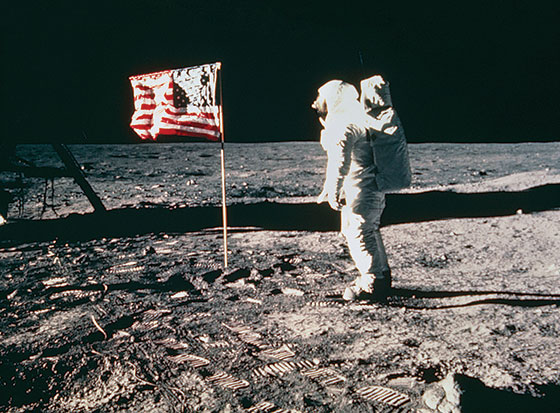 |
(Photo: SSPL/Getty Images ) |
Millions of Americans believe the moon landing was staged. The U.S. government, desperate to either beat the Soviets in the space race (which we were not capable of doing fairly) or distract from Vietnam, put Neil Armstrong under klieg lights on a soundstage, maybe as Stanley Kubrick directed. The smoking gun, skeptics say, is the famous Apollo photos, which NASA controls all access to, even to this day.
Inconsistencies.
Sometimes, lunar objects cover the camera’s crosshairs, suggesting a cut-and-paste job. In images of Buzz Aldrin’s descent from the module, he wears gray gloves, then white gloves, argues photo analyst Jack White (a Zapruder-film doubter, too); high boots, then low; no antenna, then an antenna; a suit with a wrist stripe, then without. He wouldn’t be changing outfits in outer space.
Shadows and hot spots.
Shadows in photos aren’t dark enough or uniform, skeptics say, even though the sun is the only light source. In one, the sun is at Aldrin’s back, yet on his front is a “hot spot,” lit by something. Seeing that, the Apollo camera engineer said, “Seems like he is standing in a spotlight.”
No stars.
Why in NASA’s photos is the sky a jet-black void? The theory isn’t that a dunderheaded studio lighting tech forgot to hit the stars switch, but that it was purposeful omission; astronomers, being pesky nerds, would’ve cross-checked every celestial body. (NASA says starlight doesn’t register on camera.)
Too many too-good photos.
Every picture, says David Percy, of the Royal Photographic Society, “would have taken a slick advertising agency hours,” but the amateur-photographer astronauts “managed it repeatedly.” In fact, so perfectly, some argue, that this must be evidence left by insiders who wanted the truth discovered.
Moon rocks.
The Apollo program’s 842 pounds of moon rocks have spawned almost as many theories regarding their veracity. Many say a letter C scrawled on the side of one Apollo 16 rock is a prop marker (more likely an eyelash from when the print was scanned in, NASA says).
False flag.
Old Glory’s slo-mo ripple effect is the original proof Armstrong and Aldrin were just overeducated actors. The moon has no air, cynics point out, hence no breeze. (NASA says the moon has no friction, so things don’t stop moving as fast, and the flag fluttered because the pole was twisted into place.)
No blast craters.
The lunar-module rocket had a thrust of 10,000 pounds—“It could blow a Cadillac into the next county!” writes Bill Kaysing, the moon-hoax patriarch—so it should have blasted dust everywhere, made a considerable dent in the moon’s surface, even torched the ground. Photos of the module on the moonscape, he says, have “no trace whatsoever of any disruption of the surface.”
And the Moon Itself Is Not Just Hollow But Probably An Alien Satellite
“The moon is bigger than it should be, apparently older than it should be, and much lighter in mass than it should be. It occupies an unlikely orbit and is so extraordinary that all existing explanations for its presence are fraught with difficulties.” —Irwin Shapiro,* Harvard-Smithsonian Center for Astrophysics
*Shapiro never actually said this, though he is quoted saying it on countless websites.

